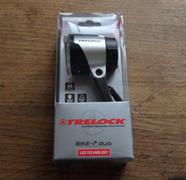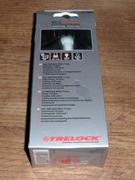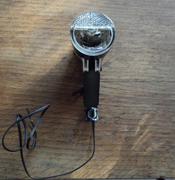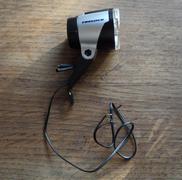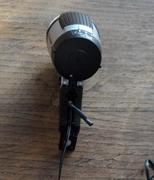Trelock LS 885
Tested: From 17 Nov. 2010
Before my test I considered this lamp one that could possibly be interesting, as it was cheaper than the Cyo, with a reasonable light beam. On the main page I wrote:
Trelock LS 885: Looks a lot like the IQ Cyo. The light pattern on the road is different. Even cheaper than the Cyo (€60). I saw a japanese website that compared the two and from a translation I think I could make out that the Cyo's beam pattern is better (see http://members2.jcom.home.ne.jp/stealth50/garage/bike/raleigh_trelock.html). I dind't intend to test this one as the manufacturer doesn't respond to email nor to messages on their website (that is important for any product...) and because I don't expect this lamp will be a match for a Cyo but I decided in the end that having tested this one would be a good addition these webpages. Btw, the road-beamshot on the Trelock website is not representative of what you will see in real life, because in that shot the cutoff is not pointed below the horizon! (you can see this by looking at the light on the trees) That's very, very bad for oncoming traffic as you can read on my page about annoyances from lamps.
This really looks like a clone of the Cyo, with the same type of construction: plastic housing with aluminium cooler for the LED sticking out. The mount is standard painted steel, not as nice by far as the mount currently used with the Edelux and Cyo, nor the Philips (all stainless steel). The width of the lamp at the bolt of the mounting bracket is as with the Philips SLD not 10 mm, so not standard. So you can't simply replace the light bracket with another type without some modifications. At the rear is a rotary switch, again similar to the switch on the Cyo, to switch the lamp on, off, or put it in the sensor position. This switch does not switch off the standlight when you put it in 'off' unlike recent versions of the Cyo (which is done to prevent attracting attention to a bike).
Experiences:
The beam has various artefacts in it, and it's definitely not as good as the Philips saferide LED dynamo. The beam is pointy towards the far end (the whole beam has a shape resembling a diamond as on a playing card) and still fairly bright at that position, which makes you want to angle the lamp up higher so you can see further ahead, but that means if you're not careful, that the lamp's light is not being kept below the horizon. So I now understand why the beamshots on Trelock's website are pointed upwards too much: You tend to want to do that to get more light further away, but then some part of the rest of the beam gets too high, so if you don't watch out for that (look at how high the light gets on trees or buildings on the side of the road for example), there's a natural tendency to aim it too high (The fact that the shape of the beam makes you tend to aim the lamp too high, is a minus point for this lamp). It's pretty bad that the Trelock people do that on their website though, which means they're not even aware of this...
Here are the images from Trelock:
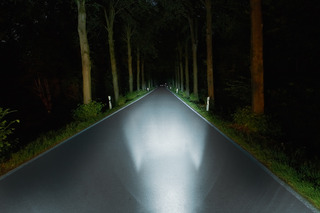
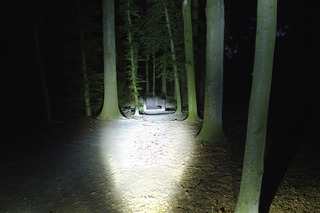
The front glass (well, plastic) lets light go up, diminishing your night vision. This is bad, you need to put a little bit of black tape over the plastic lens (or use black paint).
Despite the artefacts, I prefer the Trelock's beam to the Cyo-Nahfeld by far. The light colour is more pleasing, and it appears brighter too (everywhere). This could be due to a different spread of the light, as the Cyo's beam is spread out at large distances over a large area due to the fact that the Cyo's beam diverges...
On 17 December I used the lamp during the day + night with heavy snowfall. It was getting dark and I thought "The lamp is pretty dim, is it pointed up too much?" (because of a handlebar bag) It actually wasn't that: there was snow on the lens... After I removed the snow the beam was very bright but I noticed that actually, I now couldn't see the unevenness in the snow on the road as well as when I was mainly using the daylight which was still just enough to properly see the road. In situations of shared roads (shared with cars and trucks) you have to choose your path very carefully because you will otherwise encounter hard compressed sections or even ice lumps which result in unwanted steering to left/right or even a standstill or fall. This made it clear that the LS 885's beam wasn't wide enough and not smooth enough for such situations. This situation is comparable to riding in terrain with an MTB where it's important to have a wide even beam to be able to choose your path.
Beamshots:
For background information on making beamshots see: Camera settings, lamp settings and roads used to make the beamshots.
Road 2, camera height 1.65m, camera distance: -0.40m, camera aim: 50m on the road.
Trelock LS 885 |
Lamp height 0.75m

|
Lamp height 1.05m

|
The pattern in the light beam near the front wheel:

(Original 14 megapixel)
Conclusion:
A good lamp for the price, but if you're prepared to spend a bit more I would definitely recommend the Philips SLD.
Last modified: Thu Dec 20 04:26:07 CET 2012
